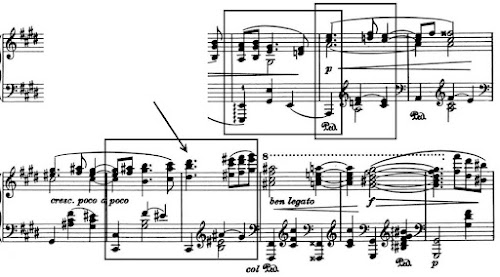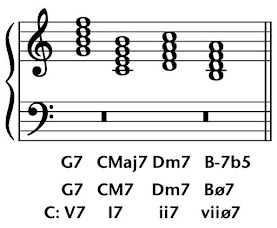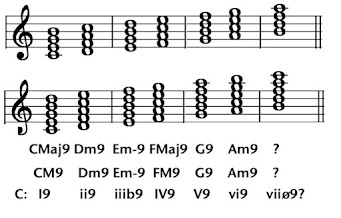In a previous post, I outlined a harmony pedagogy that would place the ninth chord near the beginning of the curriculum, not—as is typically the case (if it's taught at all)—somewhere near the end. I also noted that my plan got into trouble at the point of choosing repertoire. I'll discuss the three main reasons here: (1) repertoire bias in the traditional theory core curriculum; (2) conflict between 18th/19th century and 20th/21st century theoretical models; (3) difficulty in finding entirely diatonic examples suitable for first-year theory classroom use.
To begin, I have assembled and posted to my Google Drive a list of all the musical examples for the five essays on the dominant ninth chord that I have published on the Texas ScholarWorks platform to date:
The essays are named at the beginning of the file, and abstracts and links are provided.
(1) repertoire bias in the traditional theory core curriculum
The historical narrative for classical music that prevailed through much of the 20th century was progressive, that is, it began from one point (usually medieval chant) and led by more or less regular steps forward into contemporary music. So, we have the first inklings of counterpoint around 1000 AD, eventually a perfected polyphony in the 16th century, an organized major/minor tonal system thanks to continuo practice and pedagogy in the later 17th and early 18th centuries, and a gradual expansion or break-down of that system through more complex harmonic relations and increased chromaticism in the 19th century, till we reached a fully chromatic model epitomized by twelve-tone and serial music. Despite this scheme, the heart of the story remained with the High Classical period (sometimes called the First Viennese School) with Haydn, Mozart, and Beethoven.
This is the narrative I learned as a young student. We had only just begun to acknowledge some of its problems even by the time I started college in 1968. For my purposes here, though, and beyond noting that these repertoire biases have barely changed in mainstream college introductory theory textbooks, the one point that is immediately relevant can be easily understood by a quick comparison of the repertoire list linked above with two textbook-based lists. The smaller of the two is derived from Kostka & Payne, 3rd ed. (even earlier than my 4th ed. copy!): David Temperley corpus study: see the bottom of that web page. The larger is the table of contents for the score anthology by Benjamin, Horvit, Koozin, and Nelson, Music for Analysis, 8th edition (2018).
Temperley extracts the 46 longest examples from the Kostka & Payne workbook. Of these, 29 are by Haydn, Mozart, Beethoven, and Schubert. For these 29, 11 are from piano sonatas, 3 from other pieces for piano, 9 from chamber music, 2 from concertos, 3 songs, and 1 opera.
Benjamin, Horvit, Koozin, and Nelson has 477 examples ranging from the 17th century to the present. Of these, 378 are prior to 1900, with 175 by Haydn, Mozart, Beethoven, and Schubert. For the 378, 49 are from piano sonatas, 12 from other pieces for piano, 32 from chamber music, 2 from concertos, 15 songs and vocal ensemble music, and 5 operas. In addition, 24 are dances in keyboard format, and 37 are from orchestral ensemble music (symphonies and overtures).
For reference, in Benjamin, Horvit, Koozin, and Nelson there are two examples from Johann Strauss, jr., while in Temperley's extracts from Kostka & Payne there are none—which points up the problem: there is very little intersection between their lists and mine, in which Johann Strauss, jr. and sr. dominate. Some important caveats: Apart from the Strausses, my study of the major dominant ninth chord is skewed toward the decades surrounding 1900. As I have noted in essays, I have generally looked at shorter compositions; for longer works, I use keyboard reductions rather than full scores but I haven't focused on large instrumental ensemble music and have done even less with chamber music. I have studied dances—especially polkas and waltzes—throughout the 19th century, not just Schubert dances. The historical circumstance that ascending cadence gestures, upper-register cadences, and clear treatment of the major dominant ninth all seem to have arisen in music for dance led me to the larger repertoires that incorporated them, beginning with opéra comique in the 1830s, then blossoming in operetta in the 1850s and later. In general, composers—including Schubert himself—would be more conservative when writing in the larger instrumental forms than in the popular forms of dance music and music for the stage. In another post I will report on my look at the Allegretto grazioso quasi Andantino in Brahms's Symphony no. 2 and at his Waltzes, op. 39. Even in the midst of the Schubert craze of the 1860s—to which he also contributed—Brahms was a genius at suggesting but avoiding the two characteristic chords of scale degree ^6: the dominant ninth and the add6.
(2) conflict between 18th/19th century and 20th century theoretical models
Textbooks still lump the “extended chords” together, in a model of progressive stacked thirds, even if, as Kostka & Payne remark in their 4th ed.: "Just as superimposed 3rds produce triads and seventh chords, continuation of that process yields ninth, eleventh, and thirteenth chords (which is not to say that this is the manner in which these sonorities evolved historically)." (!!) Jazz theory, on the other hand, doesn't bother with that, because the harmonic vocabulary is based on the dominant seventh with a variety of sounds, "tensions," and alterations built on it. In Mark Levine's Jazz Theory Book (1995), for example, "extensions" (9th, 11th, 13th) are listed in the glossary, but the ninth chord is never explicitly introduced in the text. Instead, it simply appears in the first example for the II-V-I progression:
This version of the opening of "Stella by Starlight" is a concise catalogue of the three main 9th chord types, but note that none of Levine's chord labels (above the score; mine are below in blue) indicates a 9.
Here are some additional examples drawn from different places in The Jazz Theory Book. My labels are below the score. The 9 is included in the fourth chord only because it is altered (G-nat = Fx).
(* I am grateful to UT-Austin doctoral alum and friend Joel Love for telling me about Levine's book. Link: His web page.)
(3) difficulty in finding entirely diatonic examples suitable for first-year theory classroom use
My first examples would, of course, come from Schubert waltzes, but it turned out to be difficult to find simple examples of V9 without also including chromatic chords. Here is the second strain of Valses nobles, D. 969, n11 (1828), with its "textbook perfect" V9 with a direct resolution. Bars 5-6 would require some discussion, however.
In their section on the dominant ninth, Benjamin, Horvit, Koozin, and Nelson include Strauss's Künstlerleben, one of the best known of his mid-period waltzes. I don't know what they say about it, as I don't have a copy of the anthology, but I can say that I find the choice of no. 3 particularly good because the ninth appears several times in different roles, and the only chromatic consideration is a relatively simple cadence to V at the halfway point. At (a) and (c) are internal resolutions (9 resolves within V). At (b) and (d) are "almost direct" resolutions (9 is held over the first part of I); the example below the score shows what a direct resolution would have been in (b). At (e) is the upward resolution of 9 that facilitates an ascending cadence. And at (f1) & (f2) is a very common device that flips the functional status of scale degrees ^7 & ^6: at (f1) ^7 is a simple chord tone and ^6 forms the ninth, but at (f2) ^7 is an appoggiatura and ^6 is a simple chord tone.
Simplified, correct, but not as expressive version of bars 6-8:
The question of repertoire choices appropriate for different levels can be explored through the repertoire list mentioned and linked to at the top of this post. I can add here that I have studied but have not yet reported on stage works from opéras comiques of the 1830s (mainly Adam, Auber) to operetta (Offenbach, Lecocq, Strauss), Savoy opera (Sullivan), and American operetta (Herbert) and musical (Kern). And of course there is something still to be said about that "genius of avoidance," Brahms.



























